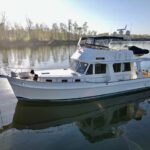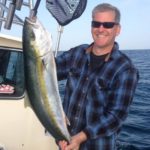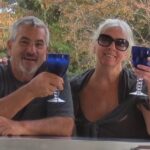Cummins Marine Diesel Repower Specialists › Forums › Cummins Marine Engines › Salt Water from Aftercooler Condensation Drain
- This topic has 6 replies, 4 voices, and was last updated 9 months ago by
 Jason Leslie.
Jason Leslie.
-
CreatorTopic
-
July 16, 2023 at 4:46 pm #151665

Matt LymanParticipantHi All –
I have a Cummins QSC 550 HP with new MOTA aftercoolers that are greased, assembled, and pressure tested (with air to 25 PSI) per SBMAR protocol 2 years ago. The boat has been 100% kept in fresh water, and has never had anything come out of the drain, unless it’s in the winter and air is cold. Which from ‘Tony’s Tips’ I understand is totally normal.
I brought the boat up from Portland to the San Juans for the first time, and when I tied up, saw a few cups of salt water (yes I tasted it) had come out of the condensation drain of each engine. Is this something to be concerned about? I find it odd that it’s happened to both. Any thoughts?
I don’t run the engine room blowers while underway, because it only get to be about 80 degrees in the engine room, and nothing else is salty in there, so I doubt it’s from the air side. The engine was run at 1400 RPM/8.5 Knots the entire time, and all the numbers and IR temps were the same between both engines incase that makes a difference.
Any help is appreciated! Thank you everyone.
-
CreatorTopic
-
AuthorReplies
-
July 28, 2023 at 4:42 pm #152362

Jason LeslieParticipantVessel Name: PierFection
Engines: Detroit 6V92TA
Location: Channel Islands, California
Country: U.S.A.
I tried to update my profile to change the Detroit 6V92 to Cummins QSC500 but I could not find a way to change it. Is that something that is possible?
Well the Detroits in this boat have historically been rebuilt at 2,500 hours for the history of the boat. They were oil leakers no matter what. I was always trying to find new areas to pad with oil diapers to slow down how much oil ended up getting to the bottom of the engine before it dripped on the large diapers under the engines (the under engine pads were changed every couple of trips). The Detroit’s had a better sound if you are someone that enjoys listening to a couple of Harley Davidsons at 4:00am on a quiet dock when preparing to go fishing. Unfortunately most live aboards at my previous dock did not have the same application. The Detroits had their own obnoxious diesel smell to them all day every day while under way. However I came to enjoy it as the familiar smell and it became the familiar smell of incredible day of fishing.
The Cummins have a bit over 2,000hr on them right now and I’m happy that they are soon to reach Broken In status not broken down or in need of an overhaul. The historical problems with the Detroits was they just could not handle the high HP and heat for more than 2,500hr and the wet liners with O-rings seemed to be the weakest link in them. I’m hoping to get 15,000-20,000 out of the QSC’s. But even if they only last 10,000hr I will still be way ahead of the game over Detroit. I Have the fresh water flush that myself and your guys designed. The boat has two 80 gallon freshwater tanks that are interconnected. The engines each have like 1.25” fittings off of each engines seacock that connects to the fresh water tanks and have ball valves. After I return to the dock I leave the engines running and head to the engine room. I open the ball valves allowing the engine to suck the fresh water from my tanks, then close the sea cocks and allow full flow from the tanks through the engines. Note.. I open the fresh water cap, put the dock fresh water hose in the filler and turn water on full prior to going to the engine room. This keeps the fresh water tanks from having a Titanic sub implosion.
My zincs get changes about every year due to deposits not from decomposing. We pulled the aftercoolers to service them on the bench and looks like that might change to every 4-5 years because they were spotless. <br /><br />The motors are virtually spotless, they do not leak any oil, they do not stink, they are very quiet in comparison, my dock mates say they sound great, and they get better fuel economy. <br /><br />
Things I like most are they are much smaller, lighter, narrower (much more engine room area to work in), parts are much lighter and easier to change and service. Parts are all available over the counter and to me it’s a much simpler motor than the Detroits. I know the QSC is a much more complicated engine in the way of electronics and sensors but it seems to have much fewer complicated parts than the Detroits. The Detroits had so many moving parts that were all interconnected like a finely tuned pocket watch. From crank shaft to fuel racks, mechanical spinning cable tachometer that drove a mechanical engine synchronization balancing a wheel between the speed difference between each tach drive cable. It was getting very hard to find a mechanic that could really work on the Detroits like an old clockmaker Detroit mechanics of yesteryear are all retiring. If you find a good one he is backed up an is paid very well for his almost obsolete skills. I can troubleshoot most problems with the QSC’s (but fortunately I have none) based on the huge library of information on your site and the assistance you provide on you forums. I am very fortunate to live and have my boat docked less than 10 minutes from you and your team. <br /><br />
The Bluefin just popped up a week ago backside of our island and they have been the larger grade. I just broke my leg and am missing out on the close to home action.
July 27, 2023 at 6:48 pm #152290
Tony AthensModeratorVessel Name: Local Banks
Engines: QSB 6.7 550 HP
Location: Oxnard, CA
Country: USA
QSC’s vs Older 6V-92 Detroits–2+ Yrs later
Jason,
Upgrade your engines on the web site and give us your honest comparison between your old 6V-92 Detroits and the QSC’s you have now.. I know the Detroits you had never said “no” to anything”..The just ran and then ran more!
Are you 2 years since we did the repower? I loose track.. Any Bluefin in the last 2 weeks? You know they are close.
July 27, 2023 at 6:57 am #152252
Jason LeslieParticipantVessel Name: PierFection
Engines: Detroit 6V92TA
Location: Channel Islands, California
Country: U.S.A.
That’s dedication
My hat is off to you for your efforts. Most people have no idea what is going on down in their engine room. They just fire it up, drive it, and put it away. The best part about this group, and Tony is that everyone is dedicated to doing the best job they can to maintain and prolong the life of their equipment. The fact is, these systems are not just to move you from point A to point B, but they are actually a life support for you and your family as you travel at sea. Keeping your equipment is in top running condition just might keep you off of the rocks. Nothing like having a mechanical failure as you are slow trolling past a reef (or boiler rocks) at the island, or having a shut down as you are approaching the break wall on a stormy afternoon and you are entering the harbor. You left out the best picture of the all in your search for identification of the water source…. I want to see the picture of you licking the water off of the fiberglass stringer. My hat is off to you for your dedication.
1 user thanked author for this post.
July 22, 2023 at 8:34 am #151986
Matt LymanParticipantI attached a clean bottle to the hose, ran for 2ish hours at 1400 RPM… Good news, it’s not salt water. At least not that I can taste. Originally I just tasted off a clean spot on the fiberglass stringer.
See the pics. Would you say this is a normal amount of water from condensation? I looks to be about a cup and a half.
To answer your questions Tony, I did the aftercooler servicing per SBMAR protocol.
July 19, 2023 at 6:28 pm #151857
Tony AthensModeratorVessel Name: Local Banks
Engines: QSB 6.7 550 HP
Location: Oxnard, CA
Country: USA
Matt, Reading this is concerning, BUT reading Gene’s post also makes total sense.. How was the water collected you tasted? In the bilge?
Curious———-who performed the aftercooler servicing? Maybe put a hose no the drain and a clean collection bottle in place?
IMO, overall I am not 100% buying into the total Mota design– The quality seems to be top notch but I do question much of the internal design in general..
Plus I do not have any long term experience with it ( nor does anyone else for that matter). We are just now a little over a full year into them with no solid feed back as to what they look like inside afer any time in servive.
July 19, 2023 at 8:31 am #151828
Gene FullerParticipantVessel Name: Yorkshire Rose
Engines: QSB5.9 380
Location: Punta Gorda, Florida
Country: USA
Unless you have an unusually calibrated sense of taste I would not consider this to be a reliable method to determine the source of the water.
There are dissimilar metals and lubricant. Either of those could lead to a “salty taste”, even if the source of the water was 100% pure and fresh.
Probably too late now, but a simple cheap TDS meter would be a better choice for testing.
-
AuthorReplies
You must be logged in to reply to this topic.
